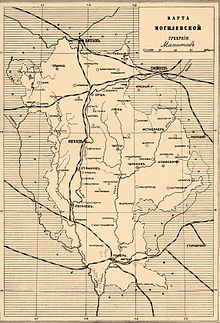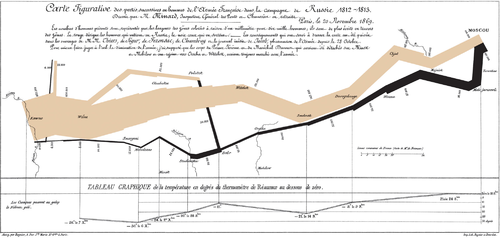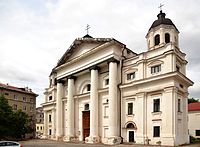Mogilev
53°55′N 30°21′E / 53.917°N 30.350°E
Mogilev
Магілёў | |
|---|---|
 Old City in winter | |
| Country Subdivision | Mogilev Region |
| Founded | 1267 |
| Government | |
| • Mayor | Vladimir Tsumarev |
| Area | |
| • Total | 118.50 km2 (45.75 sq mi) |
| Elevation | 192 m (630 ft) |
| Population (2009) | |
| • Total | 374,644 |
| • Density | 3,200/km2 (8,200/sq mi) |
| Time zone | UTC+3 |
| Postal code | 212 001 |
| Area code | +375 222 |
| License plate | 6 |
| Website | Official website |
Mogilev (or Mahilyow; Łacinka: Mahilioŭ; Template:Lang-be, pronounced [maɣʲiˈlʲou̯]; Template:Lang-ru, pronounced [məɡʲɪˈlʲof]; Template:Lang-pl; Template:Lang-yi, Molyev) is a city in eastern Belarus, about 76 kilometres (47 miles) from the border with Russia's Smolensk Oblast and 105 km (65 miles) from the border with Russia's Bryansk Oblast. As of 2011[update], its population was 360,918,[1] up from an estimated 106,000 in 1956. It is the administrative centre of Mogilev Region and the third largest city in Belarus.
History


The city is mentioned in historical sources since 1267. From the 14th century it was part of the Grand Duchy of Lithuania, and, since the Union of Lublin (1569), part of the Polish-Lithuanian Commonwealth, where it became known as Mohylew. In 16th-17th century the city flourished as one of the main nodes of the east-west and north-south trading routes.
In 1577 Polish King Stefan Batory granted it city rights under Magdeburg law. In 1654, the townsmen negotiated a treaty of surrender to the Russians peacefully, if the Jews were to be expelled and their property divided up among Mogilev's inhabitants. Tsar Aleksei Mikhailovitch agreed. However, instead of expelling the Jews, the Russian troops massacred them after they had led them to the outskirts of the town.[2] After the First Partition of Poland (1772) Mogilev became part of the Russian Empire and became the centre of the Mogilev Governorate.
In the years 1915–1917, during World War I, the Stavka, the headquarters of the Russian Imperial Army was based in the city and the Tsar, Nicholas II, spent long periods there as Commander-in-Chief.
Following the Russian Revolution, in 1918, the city was briefly occupied by Germany and placed under their short-lived Belarusian People's Republic. Then, in 1919 it was captured by the forces of Soviet Russia and incorporated into the Byelorussian SSR. Up to the World War II and the Holocaust, like many other cities in Europe, Mogilev had a significant Jewish population: according to the Russian census of 1897, out of the total population of 41,100, 21,500 were Jews (i.e. around 50 percent).[3]
During the Operation Barbarossa, the city was conquered by Wehrmacht forces on 26 July 1941 and remained under German occupation until 28 June 1944.[4] Mogilev became the official residence of High SS and police leader (HSSPF) Erich von dem Bach. During that period, the Jews of Mogilev were ghettoized and systematically murdered by Ordnungspolizei and SS personnel.[5] Heinrich Himmler personally witnessed the executions of 279 Jews on 23 October 1941. Later that month a number of mentally disabled patients were poisoned with car exhaust fumes as an experiment; the method of killing was thereafter applied in several Nazi extermination camps. Initial plans for establishing a death camp in Mogilev were abandoned in favour of Maly Trostenets.
In 1944, the utterly devastated city was reconquered by the Red Army and returned to Soviet domination. Mogilev then was the site of a labour camp for German POW soldiers.
Since Belarus gained its independence in 1991 Mogilev has remained one of its principal cities.
Religion
Mohilev was the episcopal see of the Latin Catholic Archdiocese of Mohilev until its 1991 merger into the Roman Catholic Archdiocese of Minsk-Mohilev.
It remains the see of the Eparchy (Eastern diocese) of Mogilev and Mstsislaw in the Belarusian Exarchate of the Russian Orthodox Church.
Economy
After World War II a huge metallurgy centre with several major steel mills was built. Also, several major factories of cranes, cars, tractors and a chemical plant were established. By the 1950s, tanning was its principal industry, and it was a major trading centre for cereal, leather, salt, sugar, fish, timber and flint: the city has been home to a major inland port on the Dnieper river since (year/period) and a domestic airport since. Since the fall of the Soviet Union and the establishment of Belarus as an independent country, Mogilev has become one of that country's main economic and industrial centres.
Cityscape
The town's most notable landmark is the late 17th-century town hall built during the times of the Polish-Lithuanian Commonwealth. The grand tower of the town hall sustained serious damage during the Great Northern War and the Great Patriotic War. It was eventually demolished in 1957 and rebuilt in its pre-war form in 2008.
Another important landmark of Mogilev is the six-pillared St. Stanisław's Cathedral, built in the Baroque style between 1738 and 1752 and distinguished by its frescoes.
The convent of St. Nicholas preserves its magnificent cathedral of 1668, as well as the original iconostasis, bell tower, walls, and gates. It is currently under consideration to become a UNESCO World Heritage site.[6]
Minor landmarks include the archiepiscopal palace and memorial arch, both dating from the 1780s, and the enormous theatre in a blend of the Neo-Renaissance and Russian Revival styles.
At Polykovichi, an urban part of Mogilev, there is a 350 metre tall guyed TV mast, one of the tallest structures in Belarus.
-
The Convent of St. Nicholas -
The Russian Orthodox church -
St. Stanisław's Cathedral -
The city center -
The Town Hall XVII-XX, 2008. Stamp of Belarus, 2012
Climate
| Climate data for Mogilev | |||||||||||||
|---|---|---|---|---|---|---|---|---|---|---|---|---|---|
| Month | Jan | Feb | Mar | Apr | May | Jun | Jul | Aug | Sep | Oct | Nov | Dec | Year |
| Record high °C (°F) | 9.8 (49.6) |
12.9 (55.2) |
19.3 (66.7) |
29.1 (84.4) |
30.8 (87.4) |
32.6 (90.7) |
34.3 (93.7) |
36.8 (98.2) |
30.6 (87.1) |
25.5 (77.9) |
14.5 (58.1) |
10.9 (51.6) |
36.8 (98.2) |
| Mean daily maximum °C (°F) | −3.0 (26.6) |
−2.5 (27.5) |
3.0 (37.4) |
12.0 (53.6) |
18.6 (65.5) |
21.5 (70.7) |
23.6 (74.5) |
22.7 (72.9) |
16.7 (62.1) |
9.9 (49.8) |
2.3 (36.1) |
−2.0 (28.4) |
10.2 (50.4) |
| Daily mean °C (°F) | −5.3 (22.5) |
−5.5 (22.1) |
−0.8 (30.6) |
6.7 (44.1) |
12.9 (55.2) |
16.1 (61.0) |
18.1 (64.6) |
17.0 (62.6) |
11.6 (52.9) |
6.0 (42.8) |
−0.1 (31.8) |
−4.2 (24.4) |
6.0 (42.8) |
| Mean daily minimum °C (°F) | −7.8 (18.0) |
−8.5 (16.7) |
−4.2 (24.4) |
2.0 (35.6) |
7.3 (45.1) |
10.8 (51.4) |
12.7 (54.9) |
11.6 (52.9) |
7.1 (44.8) |
2.6 (36.7) |
−2.3 (27.9) |
−6.6 (20.1) |
2.1 (35.8) |
| Record low °C (°F) | −37.3 (−35.1) |
−34.7 (−30.5) |
−35.0 (−31.0) |
−17.7 (0.1) |
−4.4 (24.1) |
−0.7 (30.7) |
3.0 (37.4) |
0.9 (33.6) |
−4.8 (23.4) |
−14.8 (5.4) |
−23.5 (−10.3) |
−33.4 (−28.1) |
−37.3 (−35.1) |
| Average precipitation mm (inches) | 39 (1.5) |
34 (1.3) |
39 (1.5) |
41 (1.6) |
53 (2.1) |
75 (3.0) |
81 (3.2) |
65 (2.6) |
55 (2.2) |
54 (2.1) |
45 (1.8) |
41 (1.6) |
622 (24.5) |
| Average rainy days | 8 | 7 | 9 | 12 | 15 | 17 | 15 | 13 | 14 | 15 | 14 | 10 | 149 |
| Average snowy days | 21 | 20 | 13 | 4 | 0.2 | 0 | 0 | 0 | 0.1 | 3 | 12 | 20 | 93 |
| Average relative humidity (%) | 87 | 85 | 80 | 72 | 69 | 74 | 74 | 75 | 80 | 84 | 89 | 89 | 80 |
| Source: Pogoda.ru.net[7] | |||||||||||||
Notable citizens
- Matest M. Agrest, ethnologist and mathematician
- Modest Altschuler, orchestra conductor
- Abe Anellis, microbiologist
- Irving Berlin, American composer
- Petr Elfimov, musician
- Alyona Lanskaya, singer
- Joseph Lookstein, Rabbi
- Leonid Isaakovich Mandelshtam, physicist
- Andrey Melnikov, soldier and recipient of Hero of the Soviet Union award
- David Pinski, Yiddish playwright
- Lev Polugaevsky, International Grandmaster of chess
- Leo Rogin, Economist and Writer
- Otto Schmidt, scientist, mathematician, astronomer, geophysicist, statesman, academician
- Issai Schur, mathematician
- Spiridon Sobol, Belarusian enlightener and printer, in 1631 he published the first ABC-book in Belarus
- Mikałaj Sudziłoŭski, revolutionary and scientist
- Lidiya Zablotskaya, singer
Sports
City sports teams:
- Football: FC Torpedo Mogilev,[8] FC Dnepr Mogilev, Nadezhda Mogilev
- Hockey: HK Mogilev
- Volleyball: Mogilev Lions, Kommunalnik
- Handball: Masheka
- Basketball: Borisfen
Twin towns – sister cities
Mahilyow is twinned with:
References
- ^ Ярковец, А.И. (2011). "Численность населения на 1 января 2011 года и среднегодовая численность населения за 2010 год по Республике Беларусь в разрезе областей, районов, городов, поселков городского типа". Статистический бюллетень (in Russian). Национальный статистический комитет Республики Беларусь. p. 21. Archived from the original (PDF) on 2012-02-04. Retrieved 2012-01-13.
- ^ Russia's First Modern Jews, NYU Press 1995, David Fishman, p.2
- ^ Joshua D. Zimmerman, Poles, Jews, and the politics of nationality, Univ of Wisconsin Press, 2004, ISBN 0-299-19464-7, Google Print, p.16
- ^ "Mogilev The fate of the Jews under the German Invasion & Occupation". Holocaustresearchproject.org. Retrieved 2014-08-09.
- ^ "Jewish Heritage Research Group in Belarus". Jhrgbelarus.org. Retrieved 2014-08-09.
- ^ UNESCO World Heritage Centre (2004-01-30). "St. Nicholas Monastery Complex in the city of Mahilyou – UNESCO World Heritage Centre". Whc.unesco.org. Retrieved 2014-08-09.
- ^ "КЛИМАТ МОГИЛЕВА" (in Russian). Weather and Climate (Погода и климат). Retrieved 28 November 2015.
- ^ FC Torpedo Mogilev (2015-01-30). "Official Website of FC Torpedo Mogilev". torpedomogilev.by. Retrieved 2015-10-16.
- ^ "Kragujevac Twin Cities". ©2009 Information service of Kragujevac City. Retrieved 2009-02-21.
- ^ "Sumqayıt şəhər icra hakimiyyəti. Beynəlxalq Əlaqələr". Retrieved 2010-12-29.
{{cite web}}: Unknown parameter|trans_title=ignored (|trans-title=suggested) (help) - ^ "Mogilev and Ar Rayyan signed an agreement of contact". 11 October 2010. Retrieved 12 January 2015.
External links
- Mogilev city executive committee
- Photos on Radzima.org
- Historic images of Mogilev
- Mogilev Jewish Center
- Jewish Encyclopedia on Moghilef (Mohilev)
- . Encyclopædia Britannica (11th ed.). 1911.
- The murder of the Jews of Mogilev during World War II, at Yad Vashem website.
- City and regional maps of Mogilev
- Best zoomable map of Mogilev and Belarus available, possible to see Voblasts, Rajons, cities and streets -> In page click KAPTbI up in the middle
- Zoomable map of Mogilev and in general from Belarus
- zoomable map of Belarus with low resolution
- Good overview map of roads and railways
- General overview of Baltics, Belarus and east-europe
- Belarus, topographic map
- "Baltic countries full detail railway map. Belarus and Baltics in C1 sector". Archived from the original on 23 May 2012.
- General detail, downloadable PDF map of Belarus







